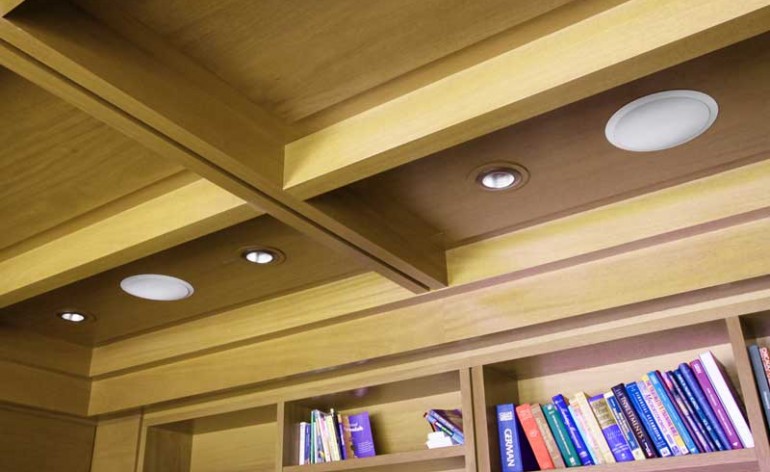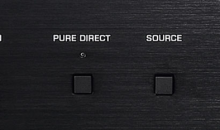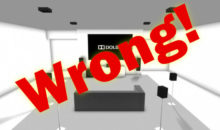In-ceiling Surround Sound Speakers
I find with many rooms it’s easy to place the front speakers. Even the center channel seems to be something that finds its place below the television or, in rare cases, above. But surround speakers often get left uninstalled or not purchased, largely because the room isn’t set up to easily handle stand-mounted or wall-mounted rear speakers. Perhaps you have a large opening on one side of the room, or there’s simply no place to put speaker stands where they need to be. For these situations, I often recommend the use of in-ceiling surround sound speakers. In-ceiling surround sound speakers let you enjoy that nice diffuse rear- and even side-channel information even when the room doesn’t make it easy to place speakers.
So while we recommend in-ceiling surrounds (but never for the main left/right/center channels), there are some caveats to consider and some general guidelines for purchasing them. As a surround sound solution it’s hard to go wrong, but following a few simple tips can help you to make a decision that will last a long time and one you won’t later regret. Of course, if you have traditional surrounds and are looking to install Dolby Atmos speakers in-ceiling, these recommendations apply as well.
Considerations for In-ceiling Surround Sound Speakers
- More Complex Doesn’t Mean More…Better
If you’re in the market for in-ceiling surround sound speakers, realize that there are a myriad to choose from. In-ceiling speakers vary from two-way to four-way and can get very complex. While we aren’t going to broad-brush all 4-way speakers, I have to say that overcomplicating these speakers doesn’t always equate to better sound. - Backboxes are Good for Sound Quality
Most entry-level in-ceiling speakers are going to lack an included backbox. That means that they simply get installed into the ceiling with what’s called an “infinite baffle” That’s not a device, that’s your attic. It means there’s no backbox. It also means that you can’t really have insulation touching the speaker and that you’re now subjecting the speaker to the humidity, heat or cold of your attic depending on the season and where you live. It also means you can’t really know how those speakers will sound in the room because a backbox truly controls the frequency response and dynamics of a driver. No backbox means there’s simply not a lot of back pressure on the driver and it will yield a much different sound in different environments and under different conditions.
And here’s another tip: If the speaker doesn’t come with a backbox, but has one as an optional available accessory. It should also come with a way to tell the speaker that it now has a backbox—because the sound and output are going to change. The thing is, though, most products don’t do this, so take that into consideration as you figure out which speakers to select for your install.
- Backboxes are Good for Energy Efficiency
For energy efficiency alone—the ability to cover the speaker in R40 insulation—I’d recommend getting a speaker with a backbox, or one that lets you purchase it as an optional accessory. There are also aftermarket universal solutions, but again, now you’re putting a product on another product for which it was never designed. If it’s up to me, I always select a product with a backbox so I can not have to worry about replacing it 5 years later due to dry rot or mold issues. Plus, you separate the heat and cold of the attic from your home by more than just the material of the woofer cone. - Speaker Connectors are Important if you Already Ran Thick-Gauge Wire
I installed some surround sound speakers once (OK, more than once) and the speaker wiring was 12-gauge. Trouble was, the connectors on the speaker only supported 14 gauge wire. I had to trim up the cable to get it to fit. This isn’t tragic, but you may want to make sure your cables aren’t better quality than your speakers! Dropping the gauge at the last stage isn’t a big deal, lots of installers do it. It just makes for a sloppier install. Another option is to attach or solder pin connectors to your wire, which can clamp easily into most spring clip connections. It’s up to you and your level of detail to the job. There’s no universally accepted way to do it, but there are a ton of wrong ways! - Size Matters (Yoda was Wrong)
I tend to pay attention to the frequency response of the in-ceiling surround sound speakers when spec’ing them for a room. A larger 8-inch woofer, for example, is going to give you a lot of bass response while a smaller 4-inch driver is never going to hit the lowest parts of the frequency range. The important metric to hit cleanly, of course, is 80Hz. That way you can be assured that everything above your subwoofer’s crossover point can be handled by all speakers in the system. Some surround receivers offer independent crossover settings per channel, but I still like to simplify my installs by unifying that metric. An 8-inch woofer may get down to around 45Hz or lower while the bottom end of a 6.5-inch model may be closer to 70Hz at volume. Manufacturers have varying specs on this and so it’s often hard to compare. - Fire Up that Grille!
It may seem trivial, but I really think the grilles used on in-ceiling surround sound speakers matter and deserve some attention. Some are snap-on models that are made of plastic and break quite easily. These also tend to be thick and stand out, as if to shout, “Here I am! I’m an in-ceiling speaker!” Others are made from metal, are paintable, and feature a magnetic attachment mechanism that lets them pop on and off with ease (but only when you want them to). Most of the new magnetic grilles are also paintable, so you can blend them perfectly into your ceiling. A grille may not be important to you, but I’ve been impressed by the new methods manufacturers are experimenting with in order to hide these ceiling speakers from view.
Conclusion
In-ceiling speakers used to be a very small segment, but they are gaining in popularity. They sound better, work better in newer energy-efficient homes, and considerably add to the convenience of adding surround sound in homes where those rear speakers would simply be impossible to add. If an in-ceiling speaker seems right for you, start checking off the features you find important. I’m pretty certain you’ll narrow down the selection quickly and be able to find one that will work well for you.







Excellent
Info — thanks